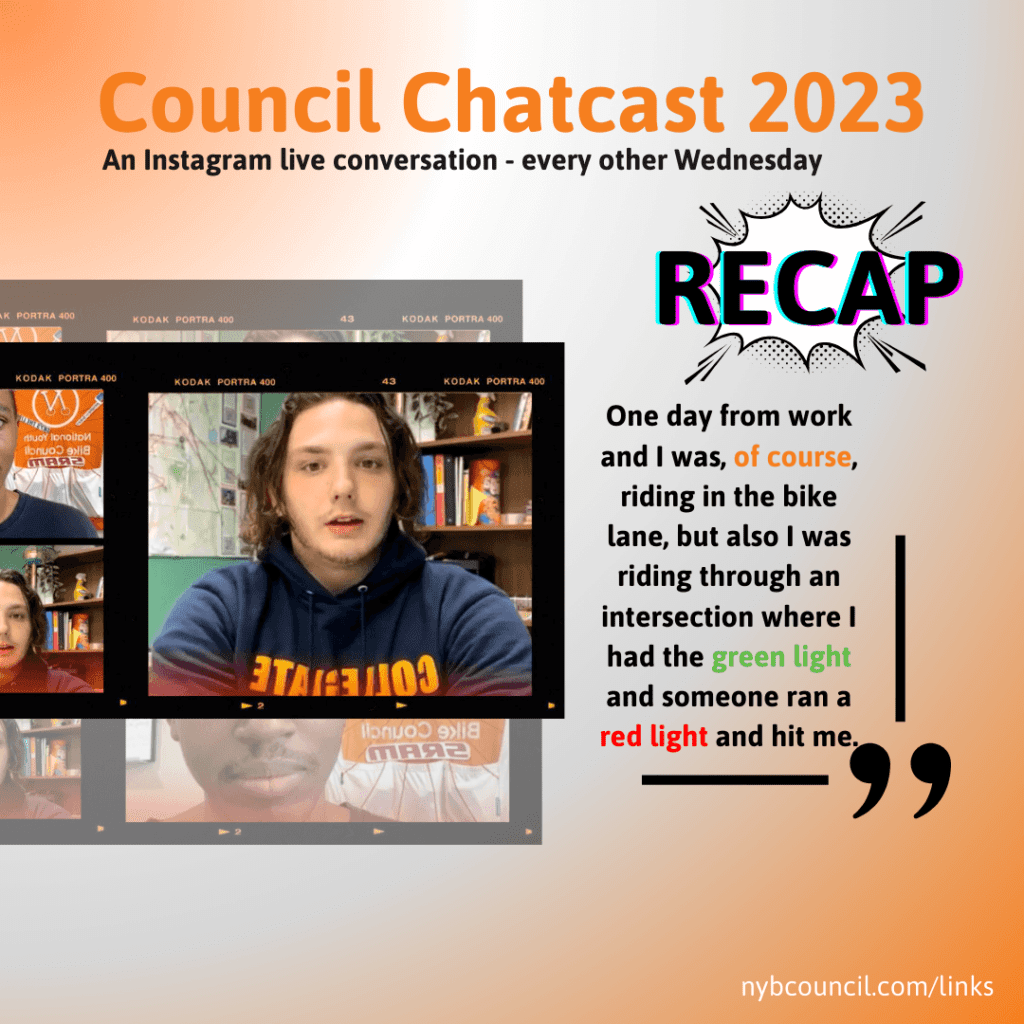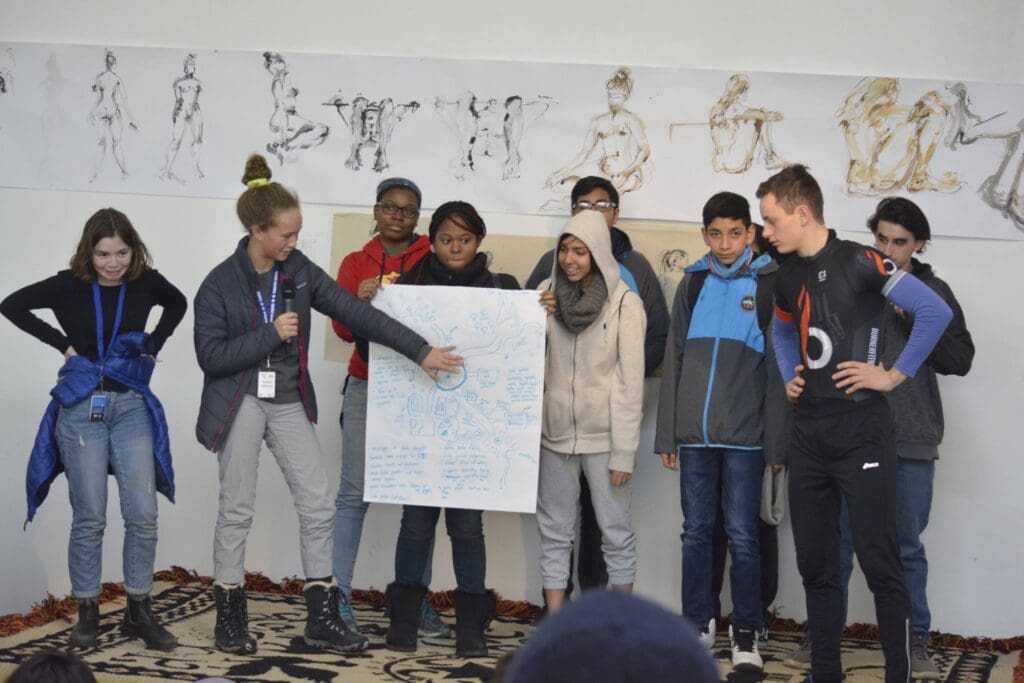By Nora B., Joshua F., and Ruth Rosas

Nora B: Hello to all! This is Nora reporting for duty as a National Youth Bike Council Member! The National Youth Bike Council (NYBC), for those who don’t know, is a youth-led nonprofit that uses the bicycle to empower young people to be leaders in their own community. We organize community projects to help youth across the country gain access to bicycles and to encourage them to keep using those bicycles. Our biggest project is the annual Youth Bike Summit which will be happening in June!
NYBC works to ensure that the youth voice is involved in the conversation on transportation. The Council brings the experience and perspectives of youth bikers, skaters, public transportation riders, walkers, and more from urban and rural settings to the table. By highlighting such diverse perspectives we hope to make communities safer for all types of commuters.
This past year, the NYBC performed “Council Chatcasts” on instagram live, which consisted of having 15-40 minute conversations with a diverse range of young people that use a bicycle as a way for commuting or recreation.
Joining me on this blog is Ruth from America Walks and today we are writing about the importance of youth voices in transportation advocacy. Take it away Ruth!
We Need More Youth in Transportation Spaces
Ruth R: Hi all, here at America Walks we believe everyone deserves walkable, equitable, connected, and accessible places in their communities. But all communities have unique needs when it comes to creating these places. Therefore, commitment to inclusivity and diversity are essential to understand what communities need and ensure their voices are part of the solution.
Our commitment to inclusivity and diversity extends beyond transportation, improving walkability or representation of young voices in transportation advocacy. America Walks is actively collaborating with youth organizations and working to incorporate the voices, perspectives, and innovative ideas of young people into our initiatives. We are particularly focused on engaging with youth from historically marginalized and underserved communities.
Our transportation systems that hinder our communities require systemic changes. Historically, marginalized and underserved communities often face disproportionate challenges related to transportation, including limited access to safe walkways, public transit, and bike lanes, which can hinder their ability to access education, employment, and healthcare. By engaging young people from these areas, organizations can better understand and advocate for solutions that directly address these disparities.
The disproportionate impact of traffic fatalities on vulnerable communities, including those without permanent residence, is a stark reminder that the most marginalized communities must be centered in our conversations.
Youth are often excluded from decision-making spaces in transportation. Despite their direct stake, knowledge, insights and ideas, young people are frequently sidelined in meetings where policies and programs are being devised. For instance, while young people constitute a significant, and growing, portion of public transport users, they are scarcely represented in transit authority boards. This impedes the development of solutions that are inclusive and reflective of diverse needs. This systematic exclusion causes issues in the way we approach policy development, community building and we risk perpetuating systems inequities that affect youth today and in the future.
Council Chatcasts Amplify Youth Voices in Transportation Advocacy

Ruth: Youth are concerned about transportation and have already begun re-imagining how to improve our streets, cities and towns. Their vision encourages connectivity and prioritizes communal well-being. Through their involvement, young people are already laying the groundwork for a better, more inclusive transportation system.
After interviewing youth from across the country through the Chatcasts, the Council has compiled some findings on what youth are experiencing in transportation and what youth want to change in transportation. Here’s some themes that resonated throughout the conversations:
- Youth are community-oriented, they recognize the importance of belonging and taking care of their community. They also want more community involvement and engagement and shared-spaces to interact with others.
- Young people across the U.S. have a deep understanding that we have built our communities around moving in cars and how car-centric culture affects their daily lives and future.
- The connection between transit use and cycling or walking is an important way to get around as a young person and the need to expand these options is essential for safe, sustainable, connected communities.
- Safety is a top concern for many youth and they are acutely aware that safety isn’t just about personal behavior and responsibility but the need for more bicycle, pedestrian and transit infrastructure and investment in improvement of existing infrastructure.
- There is a vast network of youth advocates, activists, individuals and organizations at the forefront of advocating for change. They want their voices to be heard.
Nora: One of the main themes I saw throughout the interviews was one of familiarizing people with how to bike and where to bike. A person’s biking experience is heavily reliant on whether they feel safe and comfortable while biking. One bad experience can be enough to put people off biking for a long time. An important part of this is knowing where there is biking infrastructure such as dedicated lanes or pathways and also knowing where there is lack so you aren’t caught biking with cars going 45 miles an hour.
Oftentimes apps like google maps just point you in the quickest route without taking into fact what the environment and infrastructure is like. Information about safe infrastructure is not always in accessible places for youth, youth often don’t know where to find this information or if it is available. Youth need to be included in conversations within transportation advocacy otherwise youth will be left out of the loop, for instance where to find safe infrastructure. This information is key to making biking more accessible to more people and not scare them away through bad experiences.
- Calls for accessibility and safety, through more bike lanes, especially near schools, and a safer infrastructure for cyclists in urban environments.
- A desire for more inclusive and representative biking communities, with an emphasis on breaking down stereotypes and making biking more appealing to a broader audience.
- Some individuals express a desire to learn more about bike routes and the logistics of commuting by bike, indicating a need for more accessible and lower-grade level information and education on urban cycling.
- There’s a shared vision of a future where cycling is a mainstay of urban transportation, supported by a network of bike lanes, community programs, and a culture that values and understands the benefits of biking.
- Biking is recognized as a sustainable and reliable form of transportation, and there’s an effort to familiarize people with bike infrastructure through organized city bike rides and bikepacking trips.

Get Involved
Even if you’re not creating maps for bicycles, simplifying information for how to take your bicycle on a train, or hosting learn-to-ride classes, you can still play a role in supporting the next generation of young leaders who are advocating for safer streets for young people (which retroactively makes streets safer for adults). This June, the National Youth Bike Council is hosting the Youth Bike Summit, which is a 3-day conference that everyday young people attend and their chaperones.
Sign up to support or sponsor a young person’s attendance to the Youth Bike Summit.

Do you know of a bright young individual that can speak to their experience about commuting? Refer them to the Council Chatcast to get a $25 recreational card for participating: nybcouncil.com/council-chatcast
Enable us to come to your events. There is no better way to include youth voices than to invite us and our peer youth groups directly. Reach out to us through info@nybcouncil.com.